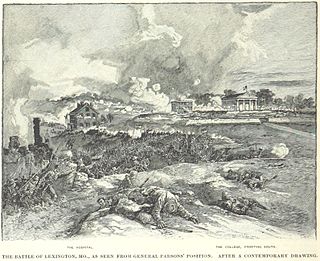
Lexington is a city in Lafayette County, Missouri, United States. The population was 4,726 at the 2010 census. It is the county seat of Lafayette County. Located in western Missouri, Lexington lies approximately 40 miles east of Kansas City and is part of the Greater Kansas City Metropolitan Area. It is the home of the Battle of Lexington State Historic Site, and of the former Wentworth Military Academy and College, the second-oldest military school west of the Mississippi River, opened in 1880.

The Battle of Wilson's Creek, also known as the Battle of Oak Hills, was the first major battle of the Trans-Mississippi Theater of the American Civil War. Fought on August 10, 1861, near Springfield, Missouri, between Federal forces and the Missouri State Guard, it is sometimes called the "Bull Run of the West."
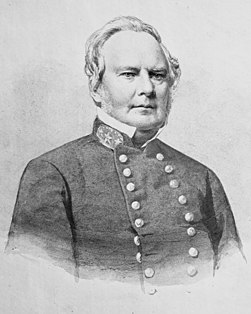
Sterling "Old Pap" Price was an American lawyer, planter, soldier, and politician from the U.S. state of Missouri, who served as the 11th Governor of the state from 1853 to 1857. He also served as a United States Army brigadier general during the Mexican–American War, and a Confederate Army major general in the American Civil War. Price is best known for his victories in New Mexico and Chihuahua during the Mexican conflict, and for his losses at the Battles of Pea Ridge and Westport during the Civil War–the latter being the culmination of his ill-fated Missouri Campaign of 1864.
The Army of the Border was a Union army during the American Civil War. It was created from units in the Department of Kansas to oppose Sterling Price's Raid in 1864. Samuel R. Curtis was in command of the army throughout its duration.

The Battle of Carthage, also known as the Battle of Dry Fork, took place at the beginning of the American Civil War on July 5, 1861, in Jasper County, Missouri. The experienced Colonel Franz Sigel commanded 1,100 Federal soldiers intent on keeping Missouri within the Union. The Missouri State Guard was commanded by Governor Claiborne F. Jackson himself and numbered over 4,000 soldiers led by a hero of Mexico, Sterling Price, along with 2,000 unarmed troops who did not participate in the battle. The battle was a strategic victory by the Missouri State Guard in large part owing to new tactics introduced on the battlefield by independent partisan rangers serving with Capt. Jo Shelby. Carthage played a part in determining Missouri's course during the war, as it helped spark recruitment for the Southern regiments. A founder of the county who fought in the battle and was then elected Lieutenant Colonel of the 13th Missouri Cavalry Regiment and 5th Missouri Infantry, attorney Robert Wells Crawford served as a recruiter for the Confederate Army in Missouri, a post he was nominated for by Waldo P. Johnson, formerly a United States Senator from Missouri in a letter to Missouri governor-in-exile Jackson dated October 24, 1862.

The Battle of Dry Wood Creek was fought on September 2, 1861 in Vernon County, Missouri during the American Civil War. The Missouri State Guard troops were successful in their campaign to force the Union Army to abandon southwestern Missouri and to concentrate on holding the Missouri Valley.
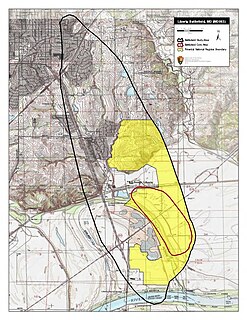
The Battle of Liberty was a battle of the American Civil War that took place on 17 September 1861, in Clay County, Missouri. Union forces unsuccessfully attempted to prevent pro-Confederate Missouri State Guards from northern Missouri from crossing the Missouri River near the confluence with the Blue River to reinforce Sterling Price at Lexington.

The First Battle of Boonville was a minor skirmish of the American Civil War, occurring on June 17, 1861, near Boonville in Cooper County, Missouri. Although casualties were extremely light, the battle's strategic impact was far greater than one might assume from its limited nature. The Union victory established what would become an unbroken Federal control of the Missouri River, and helped to thwart efforts to bring Missouri into the Confederacy.

Joseph Orville "Jo" Shelby was a Confederate cavalry general noted for his actions in the Trans-Mississippi Theater of the American Civil War.
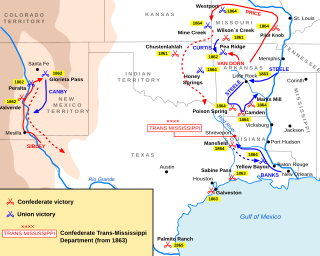
The Trans-Mississippi Theater of the American Civil War consists of the major military operations west of the Mississippi River. The area is often thought of as excluding the states and territories bordering the Pacific Ocean, which formed the Pacific Coast Theater of the American Civil War (1861-1865).
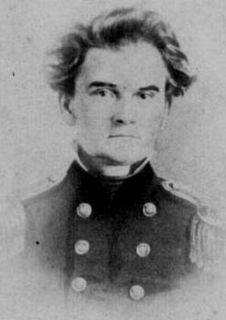
Mosby Monroe Parsons was a senior officer of the Missouri State Guard and the Confederate States Army who commanded infantry in the Trans-Mississippi Theater of the American Civil War.
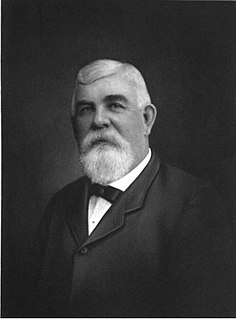
Joseph Wayne Mercer was a U.S. politician from Missouri.

During the American Civil War, Missouri was a hotly contested border state populated by both Union and Confederate sympathizers. It sent armies, generals, and supplies to both sides, was represented with a star on both flags, maintained dual governments, and endured a bloody neighbor-against-neighbor intrastate war within the larger national war.
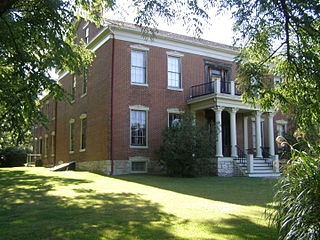
The Battle of Lexington State Historic Site is state-owned property located in the city of Lexington, Missouri. The site was established in 1958 to preserve the grounds where an American Civil War battle took place in 1861 between Confederate troops led by General Sterling Price and Federal troops led by Colonel James A. Mulligan. The site offers a short battlefield loop trail, picnicking, and tours of the battlegrounds and Oliver Anderson mansion.

Martin Edwin Green was a Confederate brigadier general in the American Civil War, and a key organizer of the Missouri State Guard in northern Missouri.
John Thomas Graves was one of the last surviving Confederate soldiers from the American Civil War.
The 16th Kansas Volunteer Cavalry Regiment was a cavalry regiment that served in the Union Army during the American Civil War and American Indian Wars.

The Lexington Historical Museum is a museum with a collection of historic items related to Lexington, Missouri. The Greek Revival building was constructed in 1846 and was added to the National Register of Historic Places in 1978. It is located in the Old Neighborhoods Historic District.
